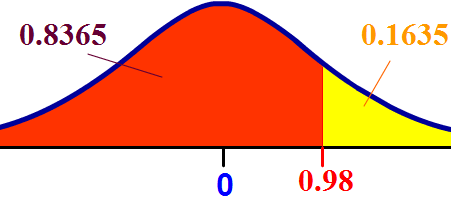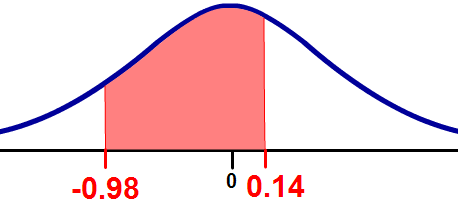Suppose that 20% of all college students are vegetarians. If 80 students are randomly selected, what is the probability that
Notice first that np = (80)(0.2) = 16 and nq = (80)(0.8) = 64 are both greater than 5. Hence we can use the normal distribution to approximate the binomial distribution. We get:
m = np = 16
- fewer than 13 of them are vegetarians?
We can write this as P(r < 13). Using the continuity correction and the normal distribution, we can approximate this probability as P(X < 12.5). Now convert this to a statement using the standard normal distribution:


The probability statement becomes: P(z < -0.98). Now we can go to the normal distribution table to get that the probability is 0.1635.
- more than 14 of them are vegetarians?
We can write this as P(r > 14). Using the continuity correction and the normal distribution, we can approximate this probability as P(X > 14.5). Now convert this to a statement using the standard normal distribution:


The probability statement becomes: P(z > -0.42). Since we want the area to the right of -0.42 and the table gives us the area to the left, we use the rule of complements and subtract from 1.
P(z > -0.42) = 1 - P(z < -0.42) = 1 - 0.3372 = 0.6628
- at least 20 of them are vegetarians?
We can write this as P(r > 20). Using the continuity correction and the normal distribution, we can approximate this probability as P(X > 19.5). Now convert this to a statement using the standard normal distribution:


The probability statement becomes: P(z > 0.98). Since we want the area to the right of 0.98 and the table gives us the area to the left, we use the rule of complements and subtract from 1.
P(z > 0.98) = 1 - P(z < 0.98) = 1 - 0.8365 = 0.1635
- at most 17 of them are vegetarians?
We can write this as P(r < 17). Using the continuity correction and the normal distribution, we can approximate this probability as P(X < 17.5). Now convert this to a statement using the standard normal distribution:


The probability statement becomes: P(z < 0.42). Now we can go to the normal distribution table to get that the probability is 0.6628.
- Between 13 and 16
of them are vegetarians?
We can write this as P(13 < r < 16). Using the continuity correction and the normal distribution, we can approximate this probability as P(12.5 < X < 16.5). Now convert this to a statement using the standard normal distribution. Compute the two z-scores:
 and
and


The probability statement becomes: P(-0.98 < z < 0.14). From the diagram, we see that the area under the normal curve between z = -0.98 and 0.14 is the area to the left of 0.14 minus the area to the left of -0.98. That is
P(-0.98 < z < 0.14) = P(z < 0.14) - P(z < -0.98)
= 0.5557 - 0.1635
= 0.3922